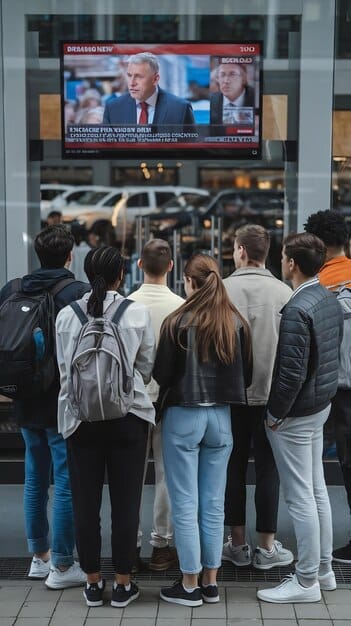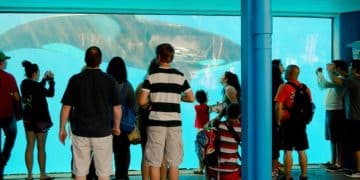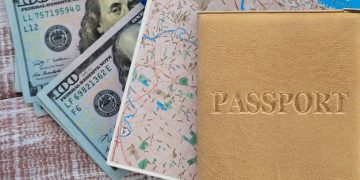US Visa Requirements 2025: What Travelers Must Know Now

Navigating the intricate landscape of international travel requires up-to-date information, and for 2025, a critical question for many is whether the US is considering new visa requirements or significant changes to existing policies, impacting travelers worldwide.
As 2025 approaches, many individuals planning to visit the United States are asking: Is the US Considering New Visa Requirements for 2025? What Travelers Need to Know Now? The answer to this complex question is crucial for seamless international travel, affecting everything from planning itineraries to understanding entry protocols.
Understanding the Current US Visa Landscape
Before delving into potential changes for 2025, it’s essential to grasp the fundamental structure of current US visa policies. The United States employs a sophisticated system designed to manage millions of visitors each year, balancing national security interests with the facilitation of legitimate travel and commerce. This framework categorizes visitors based on their purpose of travel, duration of stay, and country of origin.
The primary routes for short-term visits include various non-immigrant visas, such as the B-1 for business and B-2 for tourism, often combined as a B1/B2 visa. Additionally, the Visa Waiver Program (VWP) allows citizens of certain countries to travel to the US for tourism or business for up to 90 days without obtaining a visa, provided they obtain an approved Electronic System for Travel Authorization (ESTA). These established systems have been in place for years, forming the bedrock of US entry requirements.
The VWP, in particular, is a cornerstone for many international travelers. It alleviates the need for a full visa application process, simplifying travel for eligible citizens from 40 participating countries. However, even under the VWP, an ESTA approval is mandatory, requiring travelers to provide personal and travel-related information for security screening. Understanding the nuances of these existing regulations is the first step in preparing for any future adjustments.
Key Non-Immigrant Visa Categories
The US Department of State outlines numerous non-immigrant visa types, each tailored to specific travel purposes. Knowing which category applies to your travel plans is paramount:
- B-1 Visa: For temporary business travelers, including attending conferences, negotiating contracts, or consulting with business associates.
- B-2 Visa: For tourism, vacations, visiting family/friends, medical treatment, or participation in social/recreational events.
- F-1/M-1 Visas: For students accepted into academic or vocational programs.
- J-1 Visa: For participants in exchange visitor programs, including au pairs, interns, and academic scholars.
These categories are rigorously defined, and applicants must demonstrate their intent to return to their home country and possess sufficient funds to support their stay. The application process typically involves an online form (DS-160), a fee, and an interview at a US embassy or consulate, which can vary significantly in waiting times depending on the location and visa type.
In conclusion, the current US visa landscape is a multi-tiered system designed to manage a vast array of international visitors. Familiarity with the B1/B2 visa, the Visa Waiver Program, and specific non-immigrant categories is fundamental for anyone planning a trip to the United States. Changes, if any, will likely build upon or modify this existing framework.
Sources and Speculations: What’s Driving the Talk of New Requirements?
Discussions around potential new US visa requirements for 2025 are often fueled by a mix of official statements, legislative proposals, and geopolitical shifts. It’s crucial for travelers to distinguish between concrete policy changes and mere speculation. Several factors typically underpin such discussions: national security concerns, economic impacts, and evolving global health situations.
In recent years, the emphasis on enhancing border security and improving the vetting process for all incoming travelers has been a consistent theme in US policy. This has led to incremental changes, such as more stringent data collection in ESTA applications and increased scrutiny during visa interviews. While these haven’t amounted to entirely “new” visa requirements, they represent an evolution of existing protocols.
Another significant driver is the dynamic nature of international relations. Changes in diplomatic ties or the emergence of new security threats in specific regions can sometimes trigger a review of visa policies related to those areas. However, blanket changes affecting all travelers are rare and typically involve extensive legislative debate and public discourse before implementation.

Official Statements vs. Media Speculation
Travelers should prioritize information from official US government sources, such as the Department of State, US Customs and Border Protection (CBP), and the Department of Homeland Security (DHS). These agencies are the authoritative bodies for announcing and clarifying any changes to visa or entry requirements. Media reports, while often well-intentioned, can sometimes misinterpret or prematurely report on proposed policies.
- Department of State Travel Advisories: Always check the official website for country-specific travel advisories and entry requirements.
- CBP and DHS Announcements: These agencies are responsible for implementing border security and immigration policies; their websites are critical for official updates.
- Legislative Updates: Keep an eye on legislative proposals from Congress, as new laws can directly impact visa policies, though the process is often slow.
It’s important to remember that legislative processes are often lengthy and subject to change. A proposed bill is far from a finalized law, and even when passed, it can take time for implementation. Therefore, immediate panic over a mere proposal is often unwarranted.
Economically, visa policies can also be influenced by a desire to boost tourism or attract skilled labor. Conversely, they can be tightened during periods of economic uncertainty to prioritize domestic employment. These economic considerations can subtly shape discussions about who is allowed to enter and under what conditions. While the conversations about new requirements are constant, travelers must rely on verified sources and understand the multifaceted reasons behind potential policy shifts.
Potential Areas for Change: Biometrics, Digitalization, and Security Enhancements
Looking ahead to 2025, any significant changes to US visa requirements are likely to fall into several key areas: enhanced biometric collection, further digitalization of processes, and broader security enhancements. These are trends already observed in global travel and represent a natural evolution of border control measures. The aim is often to streamline legitimate travel while simultaneously bolstering national security.
One major area of focus continues to be biometrics. While fingerprinting and facial recognition are already standard for most visa applicants and VWP travelers, 2025 could see an expansion of these requirements, perhaps through more advanced scanning technologies or their integration at different stages of the travel process. The goal is to create a more robust identity verification system that is harder to circumvent.
Digitalization is another sector ripe for evolution. The move towards electronic applications and digital processing is a global phenomenon. For the US, this could mean further refining the online visa application system (DS-160) or even developing new digital platforms for specific types of pre-screening or status checks. A fully paperless process, while a long-term goal, might see new milestones in 2025, reducing processing times and improving data accuracy.
Enhanced Vetting Procedures
Security enhancements are continuously being sought to protect national interests. This might involve more detailed background checks, increased data sharing with international partners, or the use of artificial intelligence to identify potential risks. Travelers might find that the information requested during visa or ESTA applications becomes more granular, requiring disclosure of social media handles or more extensive travel history.
- Advanced Biometric Collection: Implementation of new biometric modalities or expanding their use points beyond the initial application.
- Digital Application Improvements: Streamlined online forms, improved user interfaces, and faster digital processing.
- Data Analytics and AI: Increased use of sophisticated algorithms to analyze traveler data for security risk assessment.
These enhancements are typically justified as necessary measures to combat terrorism, prevent illegal immigration, and address other transnational threats. While they may add layers to the application process, they are generally applied uniformly and with transparency regarding their purpose.
It’s important for travelers to stay informed about these potential shifts. Being prepared for more detailed information requests and evolving technological requirements will contribute to a smoother application and entry process. The overarching theme for 2025 is likely to be a blend of technological advancement and intensified security protocols, rather than a complete overhaul of the visa system itself.
Impact on Different Traveler Groups
Any potential changes to US visa requirements for 2025 would inevitably have varying impacts on different groups of travelers. Understanding these distinctions is key to anticipating how future policies might affect your specific travel plans. Generally, these groups can be categorized by their country of origin (VWP vs. non-VWP countries), purpose of travel, and frequency of visits.
Travelers from Visa Waiver Program countries, for instance, might experience different types of adjustments compared to those requiring a full visa application. Changes for VWP citizens are more likely to involve modifications to the ESTA application, such as expanded data collection fields or slightly longer processing times, rather than a sudden requirement for a traditional visa. The VWP is a cornerstone of US diplomatic relations and is generally maintained, with adjustments focused on program integrity.
For individuals from countries that require a B1/B2 tourist visa, potential changes could include more rigorous interview processes, additional documentation requirements, or even adjusted visa validity periods. These changes would aim to further strengthen the vetting process, ensuring that visitors meet all eligibility criteria and do not pose a security risk or intend to overstay their authorized period.
Business vs. Leisure Travelers
The distinction between business travelers and leisure tourists also matters. While both typically use B visas, changes could disproportionately affect one group. For example, business travelers might face new requirements regarding company sponsorship letters or detailed itineraries to verify the legitimacy of their commercial activities. Leisure travelers, conversely, might encounter greater scrutiny regarding proof of ties to their home country, such as employment or property ownership.
- VWP Travelers: Anticipate potential enhancements to ESTA questions and processing, not likely a complete removal of VWP eligibility.
- Visa-Required Travelers: Could see stricter interview procedures, additional supporting documentation, or longer processing times.
- Business Visitors: Might need more detailed endorsements from their employers or hosts in the US.
- Students and Exchange Visitors: Could face renewed focus on academic progression and program compliance checks.
Frequent travelers, regardless of their visa status, might also be subject to specialized scrutiny. While their travel history could simplify some aspects, ensuring they have consistently adhered to their visa terms and haven’t overstayed previous visits will remain a high priority for US immigration authorities. Therefore, staying compliant with all current regulations is the best preparation for any future adjustments. The diverse nature of global travel means that any policy shifts will be carefully calibrated to manage specific risks while minimizing undue burden on legitimate visitors.
Preparing for Possible Changes: Best Practices for Travelers
Regardless of whether significant new visa requirements are implemented in 2025, adopting best practices for international travel to the US is always advisable. Proactive preparation can save time, reduce stress, and prevent potential issues at the border. The cornerstone of this preparation is staying informed and ensuring all documentation is current and accurate.
Firstly, regularly check official government websites. The US Department of State’s Bureau of Consular Affairs, the US Customs and Border Protection (CBP), and the Department of Homeland Security (DHS) are the definitive sources for information regarding visa and entry requirements. Subscribe to their newsletters or follow their official social media channels for real-time updates.
Secondly, apply for visas or ESTA well in advance of your planned travel date. Processing times can vary significantly, especially during peak travel seasons or due to unforeseen circumstances. Rushing the application process increases the likelihood of errors and can lead to frustration if approval is delayed. A good rule of thumb is to apply at least three to six months before your intended departure, especially for first-time applicants.
Documentation and Digital Readiness
Ensure all your travel documents are up-to-date. Your passport should be valid for at least six months beyond your intended period of stay in the US, as per the “six-month rule,” unless your country is specifically exempt. Additionally, keep digital copies of all essential documents – passport, visa/ESTA, flight tickets, hotel reservations, and travel insurance – on a cloud service or a secure drive, in case physical documents are lost or misplaced.
- Verify Passport Validity: Ensure your passport is valid for at least 6 months beyond your planned stay.
- Check ESTA/Visa Status: Regularly confirm the validity and status of your Electronic System for Travel Authorization (ESTA) or visa.
- Organize Supporting Documents: Have copies of hotel bookings, flight itineraries, invitation letters (if applicable), and proof of sufficient funds.
- Be Honest in Applications: Provide accurate and truthful information in all applications to avoid future issues.
Finally, be prepared for potential interviews or additional questions upon arrival. US border agents have the authority to ask questions about your travel purpose, duration of stay, and financial means. Respond calmly, truthfully, and concisely. Avoid making jokes or giving vague answers. The goal is to demonstrate that you are a legitimate visitor with no intention of overstaying or violating visa terms. By adhering to these best practices, travelers can navigate potential changes with greater confidence and ease.
The Role of Technology in Future US Travel Entry
The future of US travel entry is undeniably intertwined with advancements in technology. As we look towards 2025 and beyond, innovations in artificial intelligence, biometrics, and data analytics are poised to play an increasingly significant role in shaping how international visitors enter the country. These technologies aim to enhance security screening while simultaneously improving efficiency for legitimate travelers.
Artificial intelligence (AI) and machine learning algorithms are already being deployed to analyze vast amounts of data from visa applications and travel records. In 2025, we could see more sophisticated AI systems that can identify patterns and potential risks with greater precision, reducing false positives and focusing resources on legitimate concerns. This could mean faster processing times for low-risk travelers, while higher-risk individuals receive more thorough scrutiny.
Biometric technology, currently limited primarily to fingerprints and facial recognition, is also set for expansion. Advanced biometric scanners that can capture multiple identifiers simultaneously, or even behavioral biometrics, might become more prevalent. The goal is to create a seamless, touchless entry experience through automated kiosks and gates while maintaining robust security checks. Such systems could potentially reduce queuing times and human error at points of entry.
Data Sharing and Predictive Analytics
The ability to securely share and analyze data across various government agencies, and even with international partners, is another technological frontier. Predictive analytics, driven by big data, could allow authorities to anticipate potential issues before travelers even embark on their journey. This proactive approach could lead to pre-clearance programs becoming more common, where travelers are vetted and approved before their flight, further streamlining arrival procedures.
- AI-Powered Risk Assessment: More sophisticated algorithms for identifying potential security threats from vast datasets.
- Advanced Biometric Integration: Wider adoption of facial and possibly iris recognition at more touchpoints.
- Seamless Entry Systems: Automated gates and self-service kiosks that use biometrics for quick verification.
- Enhanced Data Collaboration: Improved secure sharing of traveler information between relevant agencies and nations.
It is important to note that while these technological advancements promise greater efficiency and security, they also raise questions about data privacy and civil liberties. Balancing these concerns will be a critical challenge in the development and implementation of future travel entry systems. For travelers, this means a gradual shift towards a more digitally integrated travel experience, requiring greater accuracy in providing electronic information and adaptability to new verification methods. Understanding and embracing these technological shifts will be fundamental to navigating US entry in the years to come.
Case Studies and Precedents: Lessons from Recent Policy Shifts
Examining recent policy shifts and their outcomes offers valuable insight into how the US might approach new visa requirements in 2025. History provides numerous precedents, showing that changes are typically incremental and driven by specific events or evolving strategic priorities. Understanding these case studies helps contextualize current discussions and provides a framework for anticipating future adjustments.
One significant precedent is the introduction of the Electronic System for Travel Authorization (ESTA) in 2008 for Visa Waiver Program travelers. This was not a “new visa” but rather an electronic pre-screening mechanism designed to enhance security post-9/11. Its implementation demonstrated the feasibility of adding an extra layer of vetting without fully revoking visa-free travel for eligible countries. The ESTA system has since been refined, with additional questions and data points added over time, illustrating a pattern of gradual enhancement rather than abrupt overhaul.
Another relevant case study involves the periodic review and adjustment of visa processing fees and validity periods. These changes are often pragmatic, reflecting administrative costs or diplomatic reciprocity with other nations. While they don’t alter the fundamental requirement for a visa, they can impact the financial and logistical aspects of travel planning. Such adjustments are relatively common and typically announced well in advance.
Responses to Global Events
Global events, particularly public health crises or geopolitical conflicts, have also historically led to policy adjustments. For instance, the COVID-19 pandemic prompted a temporary suspension of certain visa services and the implementation of specific health-related entry requirements. While such measures are often temporary, they demonstrate the government’s capacity to enact swift changes in response to emergent international circumstances. Similarly, specific geopolitical concerns can lead to enhanced scrutiny for travelers from certain regions, a measure that is often targeted rather than universal.
- ESTA Implementation (2008): Demonstrated the effectiveness of electronic pre-screening for VWP travelers, adding security without abolishing visa-free travel.
- Visa Fee Adjustments: Regular changes based on administrative costs and international reciprocity, impacting travel budgets.
- COVID-19 Travel Restrictions: Showcased the government’s ability to implement temporary health-related entry requirements for public safety.
- Targeted Scrutiny: Geopolitical developments can lead to enhanced vetting for travelers from specific countries.
These precedents suggest that any changes in 2025 are likely to be carefully considered and implemented, building upon existing frameworks rather than tearing them down. Travelers should expect continuous evolution in border security and entry protocols, with a strong emphasis on data-driven decision-making and leveraging technology. Lessons learned from past changes will undoubtedly inform future policies, aiming for a balance between security and the facilitation of legitimate international travel.
Staying Informed: Official Channels and Reliable Resources
In the dynamic landscape of international travel regulations, knowing where to find accurate and up-to-date information is paramount. For anyone asking, “Is the US considering new visa requirements for 2025?”, relying on official channels and reliable resources is the only way to get conclusive and trustworthy answers. Speculation, rumors, and unverified news can lead to unnecessary anxiety and even costly mistakes in travel planning.
The primary and most authoritative source for all US visa and entry requirements is the official website of the US Department of State. This portal provides comprehensive information on all non-immigrant and immigrant visa categories, application procedures, fees, and updates. Travelers should regularly check the “Travel” section for the latest advisories and policy changes. The Department of State also manages the Consular Affairs website, which is invaluable for country-specific information and embassy/consulate contacts.
Another critical resource is the US Customs and Border Protection (CBP) website. CBP is responsible for securing US borders and regulating lawful trade and travel. Their site offers detailed information on entry procedures, permissible items, and regulations for travelers entering the United States. For Visa Waiver Program participants, the official ESTA website (esta.cbp.dhs.gov) is the only legitimate platform for applying for or checking the status of an ESTA.
Other Key Government and Non-Government Resources
While government sites are paramount, other reputable organizations can also provide valuable context and analysis. Major international travel organizations, reputable legal firms specializing in immigration, and well-established travel news outlets often provide summaries and interpretations of policy changes. However, even when consulting these resources, always cross-reference information with official government sources.
- US Department of State: Official source for visa policies, application procedures, and general travel advisories.
- US Customs and Border Protection (CBP): Information on entry requirements, border security, and direct ESTA application.
- US Citizenship and Immigration Services (USCIS): While not directly for short-term visas, USCIS provides information for longer-term stays and immigration-related questions.
- Reputable Travel News Outlets: Follow major news organizations that have dedicated sections for travel and international affairs, but always verify details with official sources.
Finally, for specific or complex situations, consulting with an immigration attorney or a certified travel agent specializing in US travel can provide personalized advice. These professionals can help navigate intricate requirements and ensure compliance. By forming a habit of checking official sources and being critical of unverified information, travelers can confidently prepare for their journeys to the United States in 2025 and beyond.
| Key Point | Brief Description |
|---|---|
| ✈️ Current System | US uses B1/B2 visas and Visa Waiver Program (ESTA) for short-term visits. |
| 💡 Potential Changes | Focus on enhanced biometrics, digitalization, and stricter security vetting. |
| ✅ Traveler Preparedness | Apply early, keep documents current, and check official government websites. |
| 🌐 Official Sources | Rely on US Dept. of State, CBP, and ESTA official websites for accurate info. |
Frequently Asked Questions About US Travel in 2025
As of now, there are no definitive new US visa requirements officially confirmed and announced for 2025. Discussions and proposals for enhanced security or processing are ongoing, but travelers should always refer to official US government sources for any confirmed changes, as policy implementations undergo extensive review and public notification processes.
Yes, the Visa Waiver Program (VWP) is expected to remain active in 2025. It is a well-established program facilitating travel for citizens of eligible countries. Any changes are more likely to involve modifications to the Electronic System for Travel Authorization (ESTA) application process rather than a complete suspension of the program itself. Stay updated via official CBP channels.
Travelers to the US in 2025 should prepare a passport valid for at least six months beyond their intended stay. Depending on your nationality, you’ll need an approved ESTA or a valid visa. Additionally, have supporting documents like flight itineraries, hotel reservations, proof of sufficient funds, and potentially a letter of invitation if visiting family or friends.
Biometrics requirements are an evolving area. While fingerprints and facial recognition are already standard, 2025 could see enhanced biometric collection methods or their integration into more automated entry systems. Travelers should be prepared for potential advancements in this technology, as the goal is to improve security and streamline the entry process for legitimate visitors.
The most reliable places to check for official US visa announcements are the websites of the US Department of State (travel.state.gov) and US Customs and Border Protection (www.cbp.gov). These government agencies are the authoritative sources for all entry requirements and policy changes. Avoid relying on unofficial news or social media for critical travel information.
Conclusion
The question of whether the US is considering new visa requirements for 2025 remains a topic of considerable interest for international travelers. While the landscape of global travel is subject to constant evolution driven by security concerns, technological advancements, and geopolitical shifts, there is currently no indication of a complete overhaul of the existing US visa system. Instead, travelers should anticipate a continuation of trends toward enhanced digital screening, more robust biometric verification, and increased scrutiny across existing programs like the Visa Waiver Program and traditional visa categories. By prioritizing official government sources for information, applying for necessary documentation well in advance, and ensuring full compliance with current regulations, travelers can navigate their journeys to the United States in 2025 with confidence and minimize potential disruptions.





